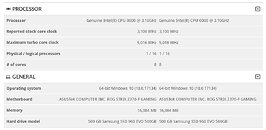Monday, July 30th 2018

Intel Core i9-9900K 3DMark Numbers Emerge: Beats Ryzen 7 2700X
Some of the first benchmark numbers of Intel's upcoming 8-core/16-thread socket LGA1151 processor, the Core i9-9900K, surfaced, from Thai professional overclocker TUM APISAK. A 3DMark database submission sees the processor score 10,719 points in the CPU tests, with an overall score of 9,862 points, when paired with a GeForce GTX 1080 Ti graphics card. According to WCCFTech, the CPU score is about 2,500 points higher than the 6-core/12-thread Core i7-8700K, and about 1,500 points higher than the 8-core/16-thread AMD Ryzen 7 2700X. The tested processor features 8 cores, 16 threads, a nominal clock of 3.10 GHz, and boost frequency of 5.00 GHz, as measured by 3DMark's internal SysInfo module. Intel is expected to launch the Core i9-9900K on 1st August, 2018.
Sources:
TUM APISAK (Twitter), WCCFTech


65 Comments on Intel Core i9-9900K 3DMark Numbers Emerge: Beats Ryzen 7 2700X
www.cin.ufpe.br/~etgs/getPDF3.pdf
www.mpedram.com/Papers/IEICE-leakage-review-journal.pdf
Looks like some people have done practical attempts at measuring the temperature dependence:
forums.anandtech.com/threads/effect-of-temperature-on-power-consumption-with-the-i7-2600k.2200205/
But yes, people will do that.
The question is as you say, the power draw, and I'll be frank - I expect these chips to be the kind of toasters that you will *need* high end air cooling to tame, if you want those 5GHz all core boosts, or any overclocking headroom at all. A Hyper 212 will not suffice to overclock these chips - at all.
In fact, I will go out on a limb and suggest that if the rumours are correct, and this is the return of solder to the Mainstream desktop, it's not because intel want the chips to run cooler and satisfy enthusiasts demands. It's because the toothpaste introduces too much variance because of the Z-height between die and IHS, and soldering is the only way they can ensure all of the chips they sell will stay within thermal limits when turbo boost is in effect. If they tried to toothpaste these, they'd end up with chips hitting TJMax even under excellent coolers.
That's my story and I'm sticking to it.
It will beat 8700k everywhere except the most ST limited scenarios, where an OCed 8700k can win. In games it should be pretty close if not outright beating the 8700k in certain titles.
If we're talking exact numbers then sorry, you'll have to wait.Interesting, we'll see if this theory about Z height is correct. Just need someone to
destroydelid their sample :DHell, even Linus got that right, even though he delidded 3 CPUs on his channel before he thought to use liquid metal on one.
We know beyond reasonable doubt that the z-height variance is there. But, use solder instead of thermal toothpaste, and that variance becomes much less important from chip to chip, which in this case, could allow Intel to sell chips that are binned extremely close to the edge of the envelope.
2. TDP has nothing to do with how much power the CPU draws..... it related to the necessary heat the Heat Sink is required to pull away from the CPU to keep it running properly. As the power draw is not static, as long as the heat sink can absorb an average heat load = to the TDP, the CPU will perform as designed. If not discussing TDP, then don't call it TDP.
3. The drop to a base frequency of 3.1 ,makes sense of a heat control mechanism. It's a logical response to the media's focus on core counts as well as a significant % of consumers who mistakenly assume that extra cores are going to do something for them.
4. A Hyper 212 is suitable for moderately overclocking any CPU; expect 10C improvement going form a $25 cooler to a $40 cooler (Mugen Max / Fuma).
5. Delidding was a thing on OIvy Bridge because it actually resulted in OC improvements ... since than, delidding has been done simply for deliddings sake based upon the assumption that "cooler is better". I don't see the point ... have not had an OC thermal limited since IB, om every OC since, have hit a voltage wall before the thermal wall.
But as you have noted, TDP is more of an average indicator, mostly used to size the heatsink, whereas in forum discussions power draw most of time refers to peak, even instantaneous usage.
Even pre-built "workstations" from OEMs like Dell and HP don't get cooling right. Just push an Optiplex a little, and it will sound like a "jet engine", with that poor stock Intel fan doing all the work, and that's on CPUs like i7-6700 (65 W).
The TDPs seem to gradually become more dishonest, but Ryzen 2 took this to a new level, where XFR 2.0 boosts extra if you have very powerful cooling on an open rig. And as I said in comments of the Ryzen 7 2700X review, Intel will probably do the same.
So 95W tdp processor will run at 0.22°C/W*95W+43.7°C = 64.7 °C with that 130W cooler. Now if you change processor with soldered IHS that Thermal profile can't be correct anymore, every one knows that using liquid metal lowers the temps not to mention solder. But if you add more cores, solder IHS on and up the freqs to meet that thermal profile again. Intel already uses that thermal profile for four core 91W(@4.2GHz) and six core 95W TDP(@3.7GHz) processors.Yeah that will be interesting to see eight core processor vs six core sixteen threads one.
Difference between 7700K Base and Max Turbo Frequency - 300MHz. (And this was a processor known to spike to nearly TJMax without delids)
Difference between 9900K Base and Max Turbo frequency - either 1.4GHz or 1.9GHz depending on which leak you believe.
This, while only hitting the same thermal envelope at BASE clocks. Clearly, then, Intel have not discovered a magic potion for power efficiency or thermal design - they have simply reduced the base clocks and hidden the true TDP behind per-core Turbo specs that they don't share TDP for.
TBH, I dont truest any numbers Intel PR puts out, there just reliable proof the numbers are actual. Intel has pulled a fast one on us all before, why would this be any different?